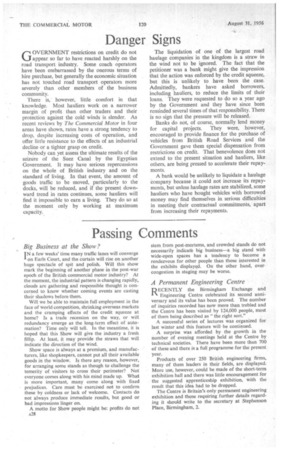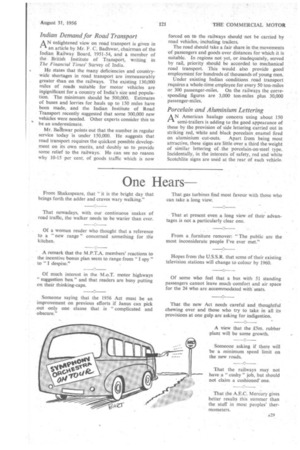Passing Comments
Page 30

Page 31

If you've noticed an error in this article please click here to report it so we can fix it.
Big Business at the Show?
TN a few weeks' time many traffic lanes will converge 1 on Earls Court, and the curtain will rise on another huge spectacle of spit and polish. Will this show mark the beginning of another phase in the post-war epoch of the British commercial motor industry? At the moment, the industrial pattern is changing rapidly, clouds are gathering and responsible thought is concerned to know whether coming events are casting their shadows before them.
Will we be able to maintain full employment in the face of world competition, shrinking overseas markets and the cramping effects of the credit squeeze at home? Is a trade recession on the way, or will redundancy emerge as the long-term effect of automation? Time only will tell. In the meantime, it is hoped that this Show will give the industry a fresh fillip. At least, it may provide the straws that will indicate the direction of the wind.
Show space is always at a premium, and manufacturers, like shopkeepers, cannot put all their available goods in the window. Is there any reason, however, for arranging some stands as though to challenge the temerity of visitors to cross their perimeter? Not everyone comes along with his mind made up. What is more important, many come along with fixed prejudices. Care must be exercised not to confirm these by coldness or lack of welcome. Contacts do not always produce immediate results, but good or bad impressions linger on.
A motto for Show people might be: profits do not A28
stem from post-mortems, and crowded stands do not necessarily indicate big business—a big stand with wide-open spaces has a tendency to become a rendezvous for other people than those interested in the exhibits displayed. On the other hand, over congestion in staging may be worse.
A Permanent Engineering Centre
RECENTLY the Birmingham Exchange and Engineering Centre celebrated its second anniversary and its value has been proved. The number of inquiries recorded has now more than trebled and the Centre has been visited by 124,000 people, most of them being described as "the right sort."
A successful series of lectures was organized for last winter and this feature will be continued.
A surprise was afforded by the growth in the number of evening meetings held at the Centre by technical societies. There have been more than 700 of these and there is a full programme for the present year.
Products of over 250 British engineering firms, many of them leaders in their fields, are displayed. More use, however, could be made of the short-term exhibition hall and there was little encouragement for the suggested apprenticeship exhibition, with the result that this idea had to be dropped.
The Centre is Britain's only permanent engineering exhibition and those requiring further details regarding it should write to the secretary at Stephenson Place, Birmingham, 2.
Indian Demand for Road Transport
AN enlightened view on road transport is given in an article by Mr. F. C. Badhwar, chairman of the Indian Railway Board, 1951-54, and a member of the British Institute of Transport, writing in The Financial Times' Survey of India.
He states that the many deficiencies and countrywide shortages in road transport are immeasurably greater than on the railways. The existing 130,000 miles of roads suitable for motor vehicles are iNignificant for a country of India's size and population. The minimum should be 500,000. Estimates of buses and lorries for hauls up to 150 miles have been made, and the Indian Institute of Road Transport recently suggested that some 300,000 new vehicles were needed. Other experts consider this to be an underestimate.
Mr. Baahwar points out that the number in regular service today is under 150,000. He suggests that road transport requires the quickest possible development on its own merits, and doubly so to provide some relief to the railways. He can see no reason why 10-15 per cent, of goods traffic which is now forced on to the railways should not be carried by road vehicles,including trailers.
The road should take a fair share in the movements of passengers and goods over distances for which it is suitable. In regions not yet, or Inadequately, served by rail, priority should be accorded to mechanical road transport. This would also provide good employment for hundreds of thousands of young men.
Under existing Indian conditions road transport requires a whole-time employee for every 50 ton-miles or 300 passenger-miles. On the railways the corresponding figures are 3,000 ton-miles plus 30,000 passenger-miles.
Porcelain. and Aluminium Lettering
AN American haulage concern using about 150 semi-trailers is adding to the good appearance of these by the provision of side lettering carried out in striking red, white and black porcelain enamel fired on aluminium cut-outs. Apart from being most attractive, these signs are little over a third the weight of similar lettering of the porcelain-on-steel type. Incidentally, in the interests of safety, red and white Scotchlite signs are used at the rear of each vehicle.




































































































